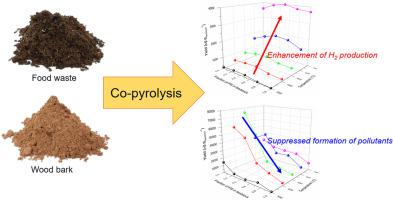Environmental Pollution ( IF 7.6 ) Pub Date : 2020-11-21 , DOI: 10.1016/j.envpol.2020.116045 Chanyeong Park , Nahyeon Lee , Jisu Kim , Jechan Lee

|
In this study, the co-pyrolysis of food waste with lignocellulosic biomass (wood bark) in a continuous-flow pyrolysis reactor was considered as an effective strategy for the clean disposal and value-added utilization of the biowaste. To achieve this aim, the effects of major co-pyrolysis parameters such as pyrolysis temperature, the flow rate of the pyrolysis medium (nitrogen (N2) gas), and the blending ratio of food waste/wood bark on the yields, compositions, and properties of three-phase pyrolytic products (i.e., non-condensable gases, condensable compounds, and char) were investigated. The temperature and the food waste/wood bark ratio were found to affect the pyrolytic product yields, while the N2 flow rate did not. More non-condensable gases and less char were produced at higher temperatures. For example, as the temperature was increased from 300 °C to 700 °C, the yield of non-condensable gases increased from 6.3 to 17.5 wt.%, while the yield of char decreased from 63.6 to 30.6 wt.% for the co-pyrolysis of food waste and wood bark at a weight ratio of 1:1. Both the highest yield of hydrogen (H2) gas and the most significant suppression of the formation of phenolic and polycyclic aromatic hydrocarbon (PAH) compounds were achieved with a combination of food waste and wood bark at a weight ratio of 1:1 at 700 °C. The results suggest that the synergetic effect of food waste and lignocellulosic biomass during co-pyrolysis can be exploited to increase the H2 yield while limiting the formation of phenolic compounds and PAH derivatives. This study has also proven the effectiveness of co-pyrolysis as a process for the valorization of biowaste that is produced by agriculture, forestry, and the food industry, while reducing the formation of harmful chemicals.
中文翻译:

将食物残渣和木皮共热解生产氢气,同时将污染物排放降至最低
在这项研究中,在连续流热解反应器中,食物垃圾与木质纤维素生物质(木皮)的共热解被认为是清洁处置和增值利用生物废物的有效策略。为了实现这一目标,主要的共热解参数(例如热解温度,热解介质(氮气(N 2)气体)的流量)以及食物垃圾/木皮的混合比对产量,组成,研究了三相热解产物(即非冷凝性气体,冷凝性化合物和炭)的性质。发现温度和食物垃圾/木皮比例会影响热解产物的产量,而N 2流量没有。在较高温度下产生更多的非冷凝气体和更少的焦炭。例如,随着温度从300°C升高到700°C,不凝性气体的收率从6.3增至17.5 wt。%,而焦炭的收率从63.6降至30.6 wt。%。食品垃圾和木皮的重量比为1:1的热解。通过以700:1的重量比与食物残渣和木树皮组合使用,既可以实现最高的氢气(H 2)气体产量,又可以最大程度地抑制酚和多环芳烃(PAH)化合物的形成。 ℃。结果表明,可以利用食物热与木质纤维素生物质在共热解过程中的协同作用来增加H 2。同时限制了酚类化合物和PAH衍生物的形成。这项研究还证明了共热解作为一种使农业,林业和食品工业产生的生物废料增值的方法的有效性,同时减少了有害化学物质的形成。











































 京公网安备 11010802027423号
京公网安备 11010802027423号